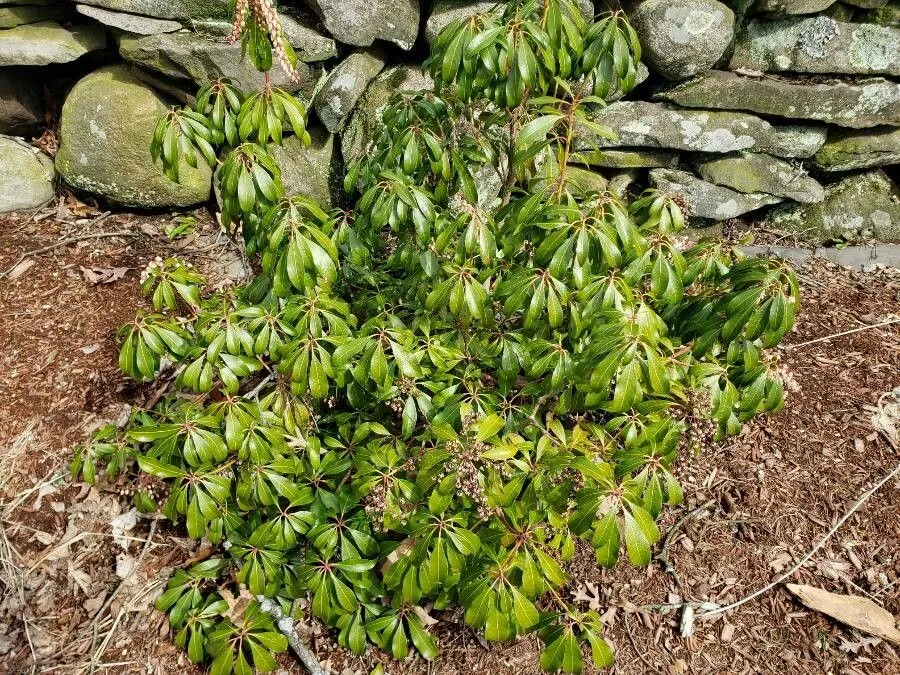
Author: D.Don ex G.Don
Bibliography: Gen. hist. 3:832. 1834
Year: 1834
Status: accepted
Rank: species
Genus: Pieris
Vegetable: False
Observations: SE. China (to Hubei), C. & S. Japan, Taiwan
The Japanese pieris, scientifically known as Pieris japonica, is a captivating evergreen shrub that belongs to the Ericaceae family. Native to the regions of Southeast China (extending to Hubei), Central and Southern Japan, and Taiwan, this plant is renowned for its resilience and ornamental value.
Heightened by its Asian origins, the Japanese pieris has been revered in gardens both in its native habitats and globally for many years. The plant typically boasts dark-green, leathery leaves that form an aesthetically pleasing contrast to its delicate blossoms. During the spring, Pieris japonica adorns itself with cascading clusters of urn-shaped flowers that range in color from white to pink. These blossoms not only add a touch of elegance to any landscape but also serve as an early source of nectar for pollinators.
One of the most distinctive characteristics of the Japanese pieris is its new growth, which emerges in vivid shades of red, bronze, or pink before maturing to a refined green. This remarkable transition adds dynamic color changes throughout the seasons, making it a versatile addition to decorative planting schemes.
The Japanese pieris thrives best in well-drained, acidic soils rich in organic matter, much like its natural forest understories. It prefers partial to full shade, making it an ideal understory shrub in woodland gardens or shaded border areas. Additionally, it is relatively low-maintenance, requiring minimal pruning and being resistant to most common garden pests and diseases. However, it is worth noting that the plant’s vibrant allure also comes with a degree of toxicity; all parts of the plant are poisonous if ingested, necessitating caution in gardens frequented by pets and children.
Historically, Pieris japonica was first described in 1834 in the third volume of “General History” (pg. 832) by botanist D.Don ex G.Don. Since then, it has captivated horticulturists and gardeners alike, holding a cherished place in plant collections and landscape designs around the world.
From traditional Japanese gardens to modern urban landscapes, the Japanese pieris continues to be celebrated for its ornamental qualities and enduring charm. Its year-round appeal, coupled with its ease of care, ensures that this elegant shrub remains a favorite among plant enthusiasts and garden designers.
Eng: japanese pieris, japanese-andromeda, lily-of-the-valley-bush
Deu: japanische lavendelheide
Fra: piéride du japon
Nob: japanpieris, pyramidelyng
Nno: japanpieris
Swe: japansk buskrosling
En: Japanese pieris, Lily-of-the-valley-bush, Japanese-andromeda, Pieris
Bg: Японски пиерис
Zh: Ma zui mu, 马醉木
Nl: Rotsheide
Fi: Japaninkellovaivero
Fr: Piéride du Japon
De: Japanische Lavendelheide
Ja: Asebi
Nb: Japanpieris, Pyramidelyng
Nn: Japanpieris
Fa: خلنگ ژاپنی
Ru: Пиерис японский
Sv: Japansk buskrosling
Zh-tw: 馬醉木
© copyright of the Board of Trustees of the Royal Botanic Gardens, Kew.
© copyright of the Board of Trustees of the Royal Botanic Gardens, Kew.
© copyright of the Board of Trustees of the Royal Botanic Gardens, Kew.
Taken Mar 24, 2022 by William Coville (cc-by-sa)
Taken Mar 25, 2022 by William Coville (cc-by-sa)
Taken Jan 25, 2022 by huy HO (cc-by-sa)
Taken Apr 7, 2022 by Mokosaw (cc-by-sa)
Taken Apr 6, 2020 by Marisa Percy (cc-by-sa)
Taken Oct 8, 2022 by Andrzej Konstantynowicz (cc-by-sa)
Taken Mar 4, 2022 by Julien Hutin (cc-by-sa)
Taken Nov 24, 2019 by fanga (cc-by-sa)
Taken Jul 28, 2021 by Annette Schmidt (cc-by-sa)
Taken Mar 25, 2022 by William Coville (cc-by-sa)
Taken Apr 4, 2020 by Leandro Martins Santos (cc-by-sa)
Taken Mar 12, 2022 by hanne stawarz (cc-by-sa)
Taken May 7, 2022 by Andrzej Konstantynowicz (cc-by-sa)
Taken Oct 8, 2022 by Andrzej Konstantynowicz (cc-by-sa)
Taken Mar 25, 2022 by William Coville (cc-by-sa)
Taken Mar 24, 2022 by William Coville (cc-by-sa)
Taken Oct 8, 2022 by Andrzej Konstantynowicz (cc-by-sa)
Taken Oct 8, 2022 by Andrzej Konstantynowicz (cc-by-sa)
Taken Jul 5, 2021 by William Coville (cc-by-sa)
Taken Mar 25, 2022 by William Coville (cc-by-sa)
Taken Mar 18, 2022 by account357 (cc-by-sa)
Taken Aug 23, 2021 by Jennifer Kappel (cc-by-sa)
Taken Jun 2, 2021 by Barbarea (cc-by-sa)
Taken Mar 27, 2020 by G Mike (cc-by-sa)
Taken Apr 30, 2022 by Amanda Kuntz (cc-by-sa)
Taken Jun 3, 2020 by Kathy Persaud (cc-by-sa)
Taken Sep 12, 2021 by Robin N (cc-by-sa)
Taken Apr 19, 2021 by Rosen Denev (cc-by-sa)
Taken Mar 13, 2022 by Dave Flack (cc-by-sa)
Taken Mar 10, 2021 by kija (cc-by-sa)
Growth form>: Multiple Stem
Growth rate>: Slow
Ph maximum: 5.5
Ph minimum: 4.2
Family: Myrtaceae Author: (F.Muell.) K.D.Hill & L.A.S.Johnson Bibliography: Telopea 6: 402 (1995) Year: 1995 Status:…
Family: Rubiaceae Author: Pierre ex A.Froehner Bibliography: Notizbl. Bot. Gart. Berlin-Dahlem 1: 237 (1897) Year:…
Family: Sapindaceae Author: Koidz. Bibliography: J. Coll. Sci. Imp. Univ. Tokyo 32(1): 38 (1911) Year:…
Family: Asteraceae Author: A.Gray Bibliography: Pacif. Railr. Rep.: 107 (1857) Year: 1857 Status: accepted Rank:…
Family: Fabaceae Author: Medik. Bibliography: Vorles. Churpfälz. Phys.-Ökon. Ges. 2: 398 (1787) Year: 1787 Status:…
Family: Aspleniaceae Author: (Cav.) Alston Bibliography: Bull. Misc. Inform. Kew 1932: 309 (1932) Year: 1932…